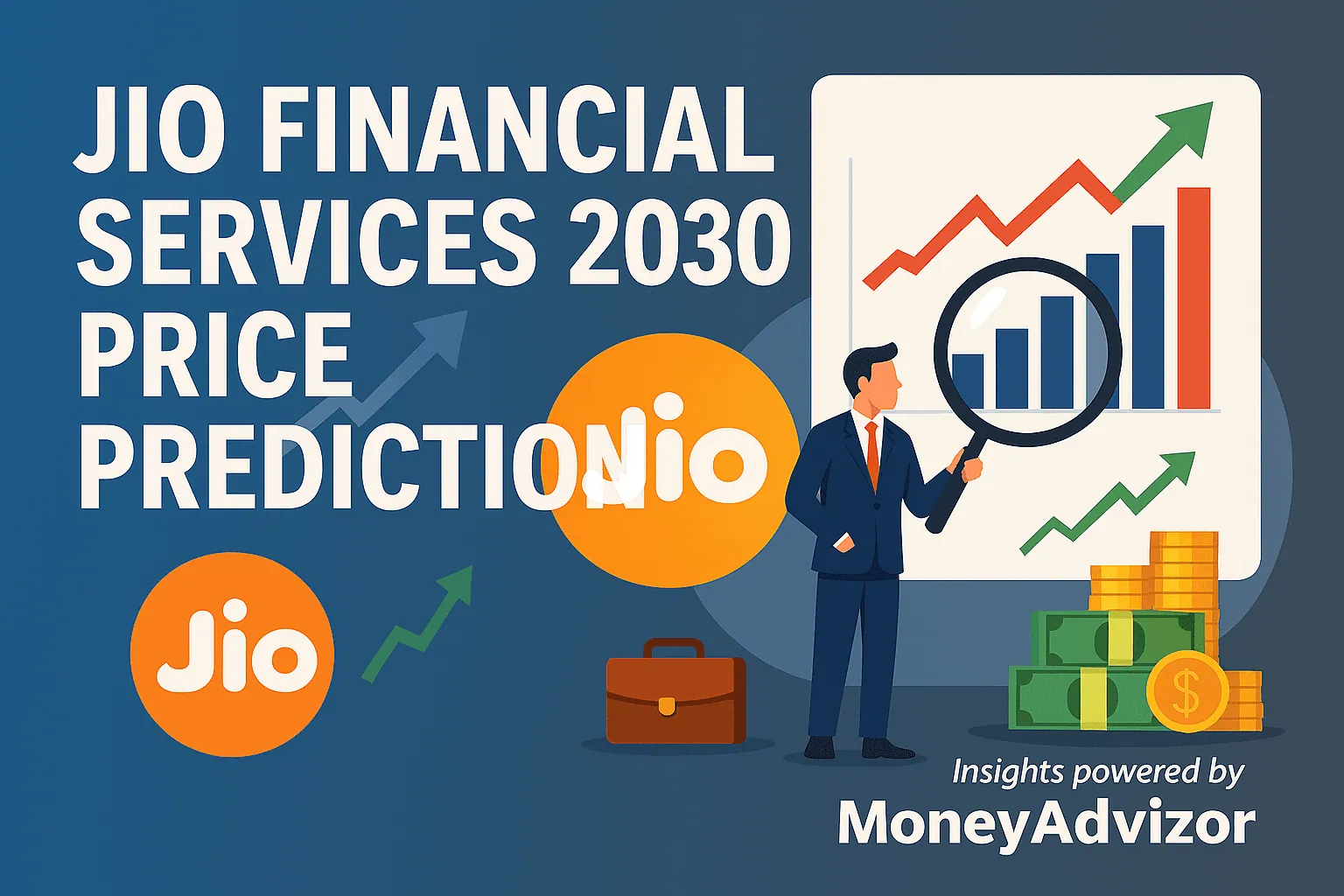Jio Financial Services (JFS) isn’t just another financial player; it’s Reliance Industries’ ambitious bet to disrupt India’s $3 trillion financial services sector. Since its demerger from Reliance in 2023 and subsequent listing, JFS has rapidly evolved from a promising concept into a multi-faceted fintech powerhouse. Predicting its stock price for 2030 requires analyzing its aggressive expansion, unique advantages, regulatory landscape, and the immense potential of India’s digital finance boom. Let’s explore realistic scenarios for where JFS could trade by the end of this decade.
JFS Today: Building the Foundation (2023-2025)
- Current Pillars:
- Lending: Consumer loans, merchant financing (JioMart tie-up), SME loans. Leveraging Jio’s massive customer data for credit scoring.
- Payments: Jio Payments Bank (digital banking), integration with JioMoney (potential UPI competitor/supplement), PoS solutions for merchants.
- Insurance: Broking partnerships (life, health, general), moving towards underwriting capabilities. Potential for embedded insurance (e.g., phone insurance at purchase).
- Asset Management: Joint Venture with BlackRock (Jio BlackRock) targeting massive passive fund growth (ETFs, index funds) in a rapidly mutualizing India.
- Digital Ecosystems: Deep integration within the Reliance ecosystem (Jio Telecom, Reliance Retail, JioMart).
- Key Advantages:
- Unparalleled Distribution: Access to Reliance Retail’s 18,000+ stores and Jio’s 450+ million telecom subscribers.
- Data Goldmine: Jio’s user behavior, spending patterns, and location data offer a significant edge in risk assessment and personalized product offerings.
- Trust of Reliance: The Reliance brand carries immense trust, crucial for financial services adoption.
- Deep Pockets: Backed by Reliance’s balance sheet for aggressive scaling and weathering initial losses.
- Technology Stack: Leveraging Jio’s 5G/6G infrastructure and AI capabilities for low-cost, scalable solutions.
The 2030 Vision: A Full-Spectrum Financial Conglomerate
JFS aims to be India’s leading “full-stack” digital financial services provider by 2030. This means:
- Dominant Lending: Becoming a top 5 retail/SME lender in India through digital-first, data-driven products.
- Mass-Market Insurance: Leading distributor and potentially a major underwriter, especially in affordable, sachet-style products.
- Asset Management Giant: Jio BlackRock becoming a top 3 AMC in India, capturing the shift from savings to investments.
- Ubiquitous Payments: A major force in UPI and digital payments, deeply embedded in Reliance’s consumer ecosystem.
- Wealth Management: Offering robo-advisory and personalized wealth solutions to India’s growing middle class.
- Potential New Verticals: Brokerage, pension products, specialized financing (e.g., green energy).
Also Read: Persistent Systems Buy Call Target Price of Rs 6800: Motilal Oswal
Key Growth Drivers Fueling the 2030 Ascent
- India’s Financial Deepening:
- Formalization: Millions moving from cash/informal credit to formal banking/digital finance.
- Rising Incomes: Expanding middle class seeking loans, investments, and insurance.
- Demographic Dividend: Young, tech-savvy population driving digital adoption.
- Government Push: Digital India, UPI, account aggregator framework (AA), ONDC (Open Network for Digital Commerce) enabling innovation.
- The Reliance Ecosystem Flywheel:
- Jio Users -> Finance: Seamless onboarding of Jio users into JFS products (loans, insurance, savings).
- Reliance Retail -> Merchant Finance: Financing millions of kirana stores and Reliance Retail suppliers.
- JioMart -> Embedded Finance: Instant credit at checkout, supply chain financing, insurance for goods.
- Data Synergy: Cross-ecosystem data continuously refining risk models and product design.
- Technological Edge:
- AI/ML: Hyper-personalization, fraud detection, automated underwriting, robo-advisory.
- Cloud-Native: Low-cost, scalable infrastructure built on Jio’s cloud capabilities.
- API-First: Easy integration with third-party platforms (e.g., ONDC sellers).
- Strategic Partnerships: Beyond BlackRock, expect alliances in insurance underwriting, specialized lending, and global fintech innovation.
Also Read: HDFC Bank Buy Call Target Price of Rs 2300: Motilal Oswal
Price Prediction Models for 2030: Scenarios & Rationale
Predicting stock prices 6 years out involves significant uncertainty. We use multiple approaches, considering different growth trajectories:
- Scenario 1: Base Case (Aggressive Growth – Most Likely)
- Assumptions: JFS executes well on core lending, payments, and AMC verticals. Jio BlackRock captures ~10-12% of the Indian mutual fund AUM by 2030 (~$150-200 billion). Lending book grows to $25-35 billion. Insurance becomes a major contributor. Profitability (PAT) ramps up significantly post-2026.
- Valuation Approach: Sum-of-the-Parts (SOTP) – Value each major vertical separately and sum.
- Lending: 3.5x-4x Book Value (similar to Bajaj Finance today).
- Payments: 8x-10x Revenue (comparable to Paytm’s historical highs, adjusted for scale).
- AMC (Jio BlackRock): 5%-6% of AUM (industry standard for profitable, large AMCs).
- Insurance: 3.5x-4x Embedded Value (EV) or Price-to-Book for brokers/insurers.
- Estimated Market Cap (2030): ₹8.5 Lakh Crore – ₹11 Lakh Crore ($100 Billion – $130 Billion).
- Estimated Stock Price (2030): ₹1,800 – ₹2,300 (Assuming minimal dilution).
- Upside from CMP (₹300-₹350): ~500% – 650%.
- Scenario 2: Bull Case (Dominant Ecosystem Player)
- Assumptions: JFS becomes the undisputed leader in digital finance, deeply integrated into every Indian’s financial life. Jio BlackRock is top 2 AMC. Lending book exceeds $50 billion. New high-margin verticals emerge (brokerage, wealth). Profit margins exceed industry averages due to tech efficiency.
- Valuation Approach: SOTP with premium multiples reflecting market leadership and ecosystem power. Potential for higher standalone P/E (40-50x) if profitability surges.
- Estimated Market Cap (2030): ₹12 Lakh Crore – ₹16 Lakh Crore ($140 Billion – $190 Billion).
- Estimated Stock Price (2030): ₹2,500 – ₹3,400.
- Upside from CMP: ~700% – 1000%.
- Scenario 3: Bear Case (Execution Challenges / Intense Competition)
- Assumptions: Slower-than-expected scaling in lending/insurance. Jio BlackRock faces stiff competition, capturing only ~5-7% AUM. Margins remain pressured due to high customer acquisition costs. Regulatory hurdles increase. Competition from banks, NBFCs (Bajaj Finance), Paytm, PhonePe, and global giants intensifies.
- Valuation Approach: SOTP with conservative multiples. Lower profitability justifies lower P/E (25-30x) or P/B multiples.
- Estimated Market Cap (2030): ₹4.5 Lakh Crore – ₹6.5 Lakh Crore ($55 Billion – $80 Billion).
- Estimated Stock Price (2030): ₹950 – ₹1,400.
- Upside from CMP: ~200% – 350%.
Also Read: Suzlon Energy Stock Price: Latest News, Deep Analysis & Future Outlook
Critical Factors Influencing the 2030 Trajectory
- Execution Excellence: Can JFS build scalable, efficient operations across diverse financial verticals? Avoiding missteps in lending underwriting is crucial.
- Profitability Timeline: When will JFS turn consistently profitable? How quickly can it achieve best-in-class margins? The market rewards profitable growth.
- Jio BlackRock Success: This JV is a potential crown jewel. Its ability to gather massive, low-cost AUM via passive funds is central to the bull case.
- Regulatory Environment: RBI, SEBI, and IRDAI regulations will shape opportunities. How supportive will they be of fintech innovation vs. traditional players? Data privacy rules are critical.
- Competitive Intensity: Can JFS outmaneuver established banks, NBFCs, and well-funded fintech rivals like PhonePe, Google Pay, and Paytm (if it recovers)?
- Technology & Cybersecurity: Maintaining cutting-edge tech while ensuring robust security against breaches is non-negotiable.
- Macroeconomic Factors: Interest rate cycles, GDP growth, and credit cycles will impact lending growth and asset quality.
Analyst Consensus & Long-Term View
- While specific 2030 targets are rare, major brokerages (Morgan Stanley, Goldman Sachs, CLSA, domestic firms) are overwhelmingly bullish long-term on JFS.
- Key Rationale: Unique ecosystem advantage, massive addressable market, strong parentage.
- Near-term focus (next 2-3 years) is on scaling loan books, building the AMC AUM, and achieving profitability. Most expect significant re-rating post sustained profitability.
- Valuation: Currently trades at a significant premium to book value (P/BV 3.5x-4x+) reflecting future growth expectations, unlike traditional NBFCs. This premium is likely to sustain if execution meets plans.
Risks Investors Cannot Ignore
- Aggressive Expansion Stumbles: Rapid scaling in lending could lead to higher NPAs if underwriting models falter.
- Regulatory Roadblocks: Stricter regulations for fintechs or ecosystem players could limit growth or increase compliance costs.
- Intensifying Competition: Deep-pocketed competitors (banks, global tech/fintech) could erode margins and market share.
- Technology Failures: System outages, cyberattacks, or failure to innovate could damage trust.
- Macroeconomic Downturn: A severe recession could hurt credit demand and increase defaults.
- Over-Reliance on Reliance: Perception as merely a subsidiary could limit standalone valuation potential. Needs to prove independent execution capability.
- Valuation Bubble: Current high expectations leave room for disappointment if growth milestones are missed.
Conclusion: Jio Financial Services – A High-Potential, High-Stakes Bet for 2030
Predicting JFS at ₹2,000+ by 2030 is not mere hype; it’s grounded in the convergence of India’s financial digitalization megatrend and Reliance’s unparalleled distribution, data, and execution prowess. The Base Case (₹1,800 – ₹2,300) represents a realistic target if JFS executes its core lending, AMC, and payments strategies effectively. The Bull Case (₹2,500+) becomes plausible if JFS achieves dominant ecosystem status and Jio BlackRock becomes a market leader.
However, this potential comes with significant risk. Execution missteps, regulatory hurdles, or intense competition could see JFS trade closer to the Bear Case (₹950 – ₹1,400), still offering substantial upside but falling short of transformative returns.
Investment Outlook:
- Long-Term Horizon Essential: JFS is a 5-10 year investment. Near-term volatility is expected as it invests heavily for growth.
- High Conviction Required: Investors must believe deeply in the Reliance ecosystem advantage and JFS’s management.
- Monitor Key Metrics: Track Loan Book growth & NIMs, AMC AUM, Insurance Premiums, Operating Profit, and ultimately, PAT trajectory.
- Diversification: Given the inherent risks, JFS should be part of a diversified portfolio, not a concentrated bet.
Jio Financial Services has the ingredients to become one of India’s most valuable companies by 2030. Its success hinges on translating its formidable advantages into profitable, scalable market leadership across multiple financial verticals. For investors with the risk appetite and a long-term perspective, JFS presents a compelling opportunity to participate in India’s next financial revolution. While the path to ₹2000+ is fraught with challenges, few players are as uniquely positioned to capture the opportunity.
for more info visit: moneyControl




